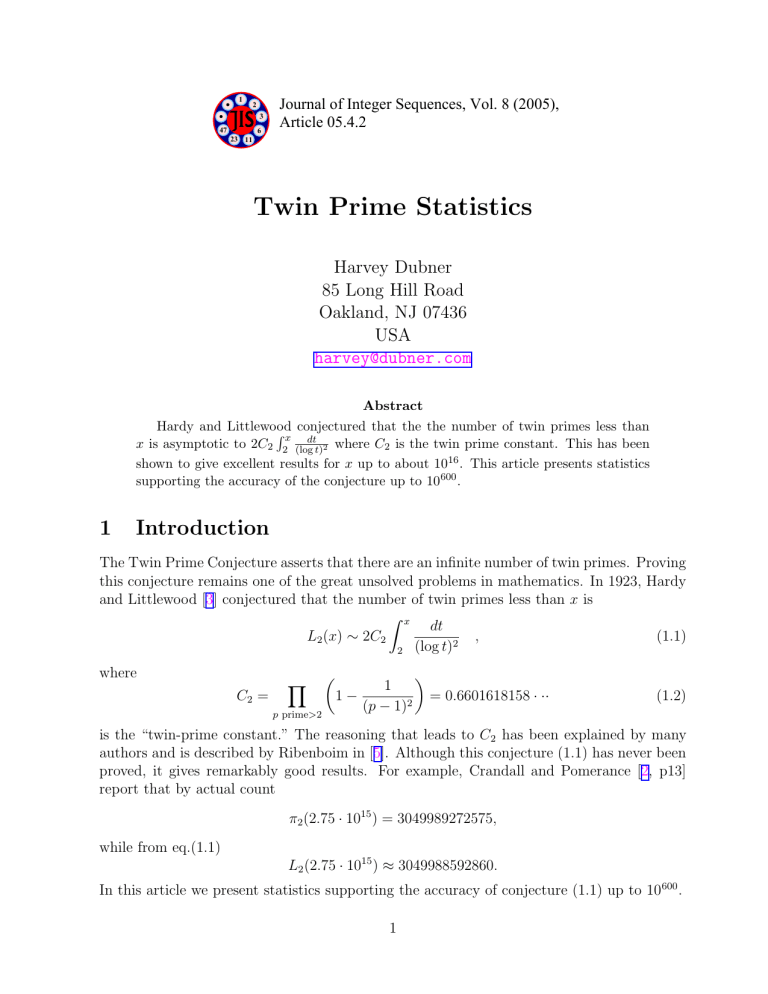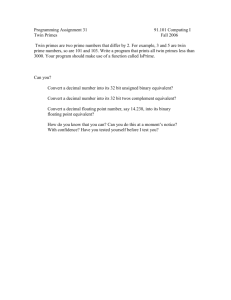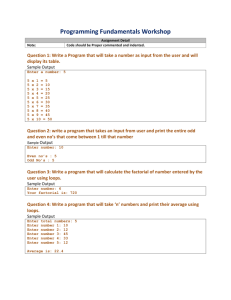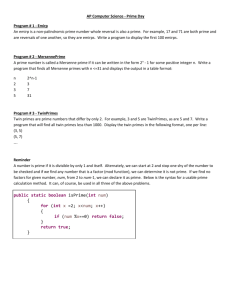Twin Prime Statistics

1
2
47
23 11
6
3
Journal of Integer Sequences, Vol. 8 (2005),
Article 05.4.2
Twin Prime Statistics
Harvey Dubner
85 Long Hill Road
Oakland, NJ 07436
USA harvey@dubner.com
Abstract x
Hardy and Littlewood conjectured that the the number of twin primes less than is asymptotic to 2 C
2
R x
2 dt
(log t ) 2 where C
2 is the twin prime constant. This has been shown to give excellent results for x up to about 10
16
. This article presents statistics supporting the accuracy of the conjecture up to 10
600
.
1 Introduction
The Twin Prime Conjecture asserts that there are an infinite number of twin primes. Proving this conjecture remains one of the great unsolved problems in mathematics. In 1923, Hardy
and Littlewood [ 3 ] conjectured that the number of twin primes less than
x is
L
2
( x ) ∼ 2 C
2
Z x
2 dt
(log t ) 2
, (1.1) where
C
2
=
Y p prime > 2
µ
1 −
1
( p − 1) 2
¶
= 0 .
6601618158 · ·· (1.2) is the “twin-prime constant.” The reasoning that leads to C
2 has been explained by many authors and is described by Ribenboim in [
5 ]. Although this conjecture (1.1) has never been
proved, it gives remarkably good results. For example, Crandall and Pomerance [
report that by actual count
π
2
(2 .
75 · 10 15 ) = 3049989272575 , while from eq.(1.1)
L
2
(2 .
75 · 10 15 ) ≈ 3049988592860 .
In this article we present statistics supporting the accuracy of conjecture (1.1) up to 10 600 .
1
2 Method
When dealing with large numbers it is obvious that using exact counts of all twin primes eventually becomes impractical, so that incremental counts have to be substituted for total counts. Equation (1.1) becomes
L
2
( x
0
, x
0
+ x ) ∼ 2 C
2
Z x
0
+ x x
0 dt
(log t ) 2 x
≈ 2 C
2
(log x
0
) 2
, (2.1) which assumes that x
0 is large enough so that log x is virtually constant over x .
To find the number of twin primes in x we actually count all the prime gaps in x . This is accomplished by processing segments of 256,000,000 numbers, first by sieving to eliminate all composite numbers with a prime factor less than 10 9 , then by subjecting the remaining numbers to a Fermat test for primality. Those that pass the Fermat test are assumed to be prime even though there is a slight chance of a small number being composite. However, any such error would not have a significant effect on the twin prime count. See below for a discussion of this topic.
We started collecting gap counts at x
0
= 10 20 . Finding 10 9 gaps, of which 28,667,923 were twins, took about 2 hours on a 2.0 GHz computer. This required the determination of the primality of about 23 · 10 9 x
0
= 10 50 took about 82 hours.
odd numbers. The same gap count problem starting at
2.1
Pseudoprimes
A number which passes a base b Fermat test might not be prime but could be psp, a base b pseudoprime. There have been various studies estimating psp frequencies but the results are asymptotic in nature and usually do not give useful information for relatively small numbers. We investigated psp’s near 10 19 because we could use 64-bit arithmetic to sieve such numbers so as to accurately and efficiently determine the composite numbers. These were all subjected to a base 3 Fermat test to determine which were psp’s.
2000 · 10 9 consecutive odd numbers near 10 the probability of an odd number near 10 19
19 were tested and 17 psp’s were found. Thus being a psp is about
Prob(psp) = 17 / (2000 · 10 9 ) = 8 .
5 · 10 − 12 .
Applying the psp probability for 10 19 error of to the 23 · 10 9 odd numbers above 10 expected error = (23 · 10 9 ) · (8 .
5 · 10 − 12 ) = 0 .
20
20 gives an expected and so we would expect to have at most one extra twin prime gap appearance in error when counting 10 9 gaps. Actually the error is considerably less than that shown since the sieving process would have eliminated most of the psp’s. For larger values of 10 n the number of expected psp’s continues to decrease, therefore it is clear that using a Fermat test to determine twin prime statistics is well justified.
Insisting on absolute accuracy in determining primes would have increased the computer time by a factor of at least 1000, making this project virtually impossible.
2
2.2
Poisson distribution
Although the exact distribution of counts of twin primes is not known, it seems reasonable to assume that such counts might be approximated by a Poisson probability distribution since this is true for almost all distributions of rare phenomena. We could then present the error between the actual and estimated twin prime counts as the number of standard deviations which effectively normalizes the error. For the Poisson distribution the standard deviation is the square root of the twin prime count. Using a common probability distribution to describe twin prime counts is not new. For example, R. Brent used that approach in a 1975 paper
[ 1 ], as did T.Nicely in 1999 in evaluating Brun’s constant [ 4 ]. We are only using probability
concepts to normalize the error in predicting twin prime counts.
3 results
The twin prime counts shown here were obtained as part of a larger project to obtain the frequencies of all prime gaps near 10 n for a wide range of n . For a given n , gap data was collected until the total of all gaps, g t
, equalled a selected limit such as 10 9 . Because of the
Prime Number Theorem this means that about g t
· log(10 n primality. Substituting this into eq.(2.1),
) numbers have to be checked for
L
2
(10 n
, 10 n
+ g t
· log(10 n
)) ≈ 2 C
2 g t
· log(10 n )
(log(10 n )) 2 g t
= 2 C
2 log(10 n )
(3.1) which is the predicted number of twin primes, shown in column four of Tables 1 and 2. The error measured in Standard Deviations,
SD = √ error actual is shown in the last column.
It is clear from examining the data in Tables 1 and 2 that the Hardy Littlewood conjecture for the count of twin primes, eq. (1.1), is “accurate” up to primes of 600 digits. The error is consistantly of the order of the square root of the actual twin prime count. Unfortunately we do not yet have any theory for improving the error prediction.
4 Acknowledgements
We wish to thank Jens Kruse Andersen for the use of his excellent program for counting pseudoprimes near 10 19 .
3
References
[1] R. P. Brent, Irregularities in the distribution of primes and twin primes, Math. Comp.
29 , (1975), 43–56.
[2] R. Crandall and C. Pomerance, Prime Numbers: a Computational Perspective , Springer-
Verlag, New York, 2001.
[3] G. H. Hardy and J. E. Littlewood, Some problems on partitio numerorum, III: On the expression of a number as a sum of primes.
Acta Math.
44 , (1923), 1–70.
[4] T. Nicely, Enumeration to 1 .
6 ∗ 10 15 of the twin primes and Brun’s constant, (1999).
http://www.trnicely.net/twins/twins2.html
[5] P. Ribenboim, The Little Book of Bigger Primes , second edition, Springer-Verlag, New
York, 2004.
2000 Mathematics Subject Classification : Primary 11B05; Secondary 11A41.
Keywords: prime gaps, twin primes, twin prime constant.
(Concerned with sequences A001097 , A001359 , and A006512 .)
Received May 3 2005; revised version received August 25 2005. Published in Journal of
Integer Sequences , August 29 2005.
Return to Journal of Integer Sequences home page .
4
Table 1: Twin Prime data for 10 20 to 10 55 total
10 43
10 44
10 45
10 46
10 47
10 48
10 49
10 50
10 55
10 37
10 38
10 39
10 40
10 41
10 42
10 31
10 32
10 33
10 34
10 35
10 36
10 25
10 26
10 27
10 28
10 29
10 30 size gaps
10 20 10 9
10 21
10 22
10 23
10 24
10 9
10 9
10 9
10 9
10 9
10 9
10 9
10 9
10 9
10 9
10 9
10 9
10 9
10 9
10 9
10 9
10 9
10 9
10 9
10 9
10 9
10 9
10 9
10 9
10 9
10 9
10 9
10 9
10 9
10 9
10 9 twin primes actual predicted error percent error error in SD
28667923 28670463 -2540 -0.0089
-0.47
27297642 27305203 -7561 -0.0277
-1.45
26069405 26064057 5348 0.0205
1.05
24933403 24930837 2566 0.0103
0.51
23885814 23892052 -6238 -0.0261
-1.28
22942786 22936370 6416 0.0280
1.34
22060593 22054202 6391 0.0290
1.36
21243727 21237380 6347 0.0299
1.38
20482302 20478902 3400 0.0166
0.75
19773012 19772733 279 0.0014
0.06
19113536 19113642 -106 -0.0006
-0.02
18503641 18497073 6568 0.0355
1.53
17913954 17919039 -5085 -0.0284
-1.20
17372782 17376038 -3256 -0.0187
-0.78
16868189 16864978 3211 0.0190
0.78
16387161 16383121 4040 0.0247
1.00
15931851 15928035 3816 0.0240
0.96
15496561 15497547 -986 -0.0064
-0.25
15090215 15089717 498 0.0033
0.13
14707109 14702801 4308 0.0293
1.12
14334329 14335231 -902 -0.0063
-0.24
13982239 13985591 -3352 -0.0240
-0.90
13650736 13652601 -1865 -0.0137
-0.50
13337659 13335099 2560 0.0192
0.70
13029542 13032028 -2486 -0.0191
-0.69
12740605 12742428 -1823 -0.0143
-0.51
12471625 12465418 6207 0.0498
1.76
12201271 12200197 1074 0.0088
0.31
11948039 11946026 2013 0.0168
0.58
11703340 11702229 1111 0.0095
0.32
11464673 11468185 -3512 -0.0306
-1.04
10426568 10425623 945 0.0091
0.29
5
10 180
10 200
10 220
10 240
10 260
10 280
10 300
10 320
10 340
10 360
10 380
10 400
10 450
10 500
10 550
10 600
10 110
10 120
10 130
10 140
10 150
10 160 size
10 60
10 70
10 80
10 90
10 100
Table 2: Twin Prime data for 10 60 to 10 600 total twin primes percent error
10 7
10 7
10 7
10 7
10 7
10 7
10 7
5 · 10 6
5 · 10 6
5 · 10 6
5 · 10 6
5 · 10 6
11 · 10 6
7 · 10 6
5 · 10 6
5 · 10 6
10 8
10 8
10 8
10 8
10 8
10 7 gaps actual predicted error
10 8 956273 955682 591 error in SD
0.0618
0.60
10 8
10 8
10 8
10 8
819450
716327
636623
572885
819156
716761
637121
573409
294
-434
-498
-524
0.0359
-0.0606
-0.0782
-0.0915
0.32
-0.51
-0.62
-0.69
520799
477439
440294
409384
382170
36006
521281
477841
441084
409578
382272
35838
-482
-402
-790
-194
-102
168
-0.0926
-0.0842
-0.1794
-0.0474
-0.0267
0.4666
-0.67
-0.58
-1.19
-0.30
-0.16
0.89
32107
28652
26213
23638
22281
20458
19181
9041
8584
8090
7410
6997
14035
8140
5084
4734
31856
28670
26064
23892
22054
20478
19113
8959
8432
7964
7544
7167
14016
8027
5212
4778
251
-18
149
-254
227
-20
68
82
152
126
-134
-170
19
113
-128
-44
0.7818
-0.0628
0.5684
-1.0745
1.0188
-0.0978
0.3545
0.9070
1.7707
1.5575
-1.8084
-2.4296
0.1354
1.3882
-2.5177
-0.9294
1.40
-0.11
0.92
-1.65
1.52
-0.14
0.49
0.86
1.64
1.40
-1.56
-2.03
0.16
1.25
-1.80
-0.64
6









